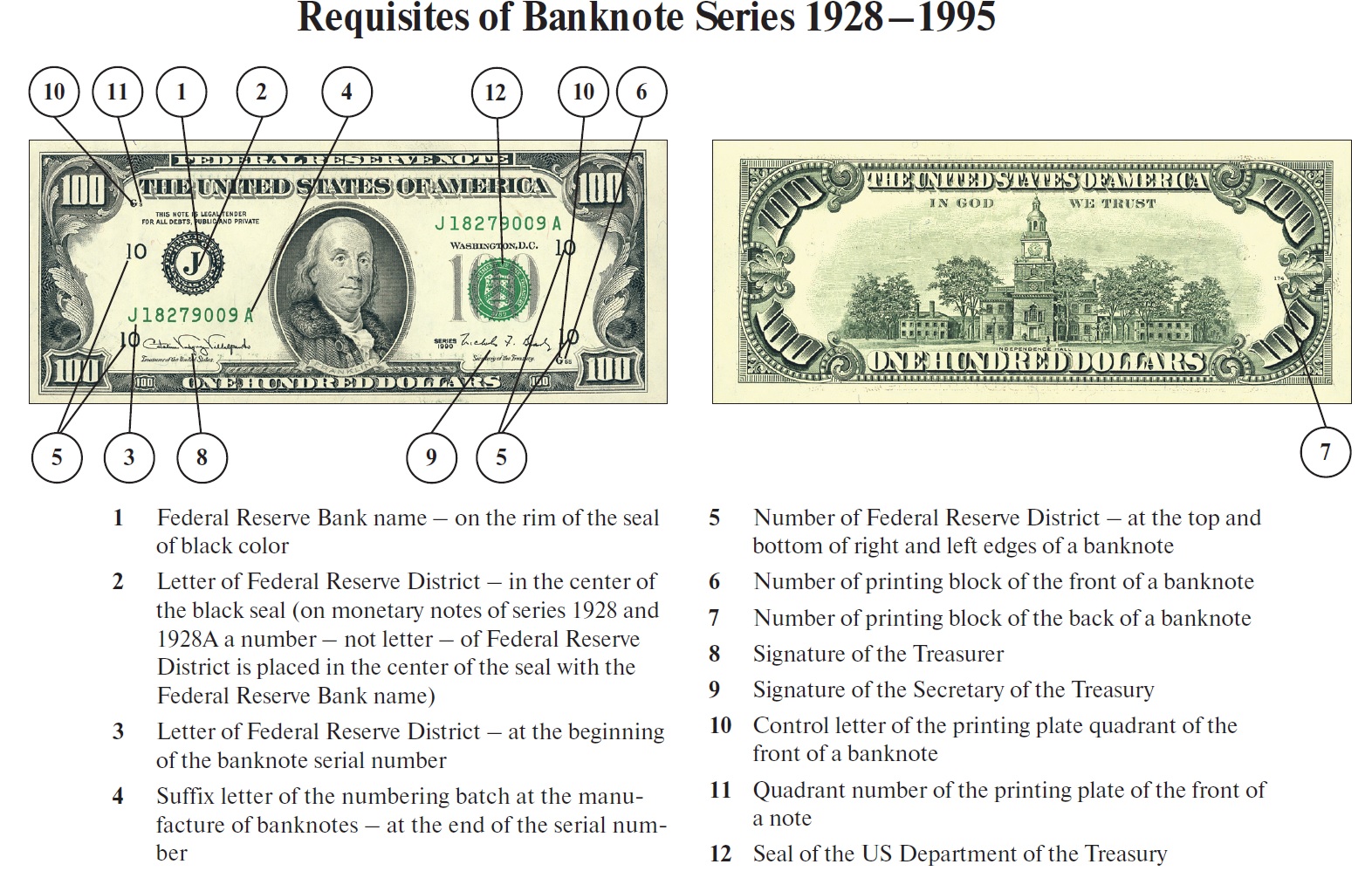
 United States of America (USA)
United States of America (USA)
Series of 1969-1988
Distictive features of banknotes of series 1969–1988 from series 1928–1934, 1950, 1963
On banknotes of all denominations of series 1969–1988 design of the seal of the US Department of the Treasury was changed, an inscription on the seal in Latin: “Thesaur. Amer. Septent. Sigil.” was changed for an inscription in English: “The Department of the Treasury 1789”.
Some banknotes of $1 denomination of series 1988A since 1992 were printed on web printing machines, and have differences in requisites from other banknotes of the series.
Facsimile of officials’ signatures are executed by intaglio printing.
In June 1963 the Silver Certificate was cancelled, in 1976 a banknote of the Federal Reserve Notes of $2 denomination was put into circulation.
In contrast to banknotes of all denominations of series 1928 and 1985, where the distribution of ferromagnetic component in the ink was even, and all metallographic images of black color possessed magnetic properties, on banknotes of series 1988 of $20, $50 and $100 denomination magnetic security has local distribution.
Design and main security features of banknotes of series 1969-1988
Dimension
156 x 66 mm
Dominating colors
Face: black, light-yellow. Back: green, light-yellow.
Paper
Light-yellow with chaotically embedded security fibers of blue and red colors.
Printing method:
Intaglio: intaglio images have an embossed relief, which is explained by paper deformation and a relatively thick layer of ink located exactly along the paper deformation profile. Face – all images (except serial numbers, the seal of the Department of the Treasury, the seal and serial numbers of the Federal Reserve Bank, a designation of series issue year, a facsimile of officials’ signatures (Treasurer and the Secretary of the Treasury). Back – all images.
Letterpress: face – serial numbers, the seal of the US Department of the Treasury to the right of the portrait, the seal of the Federal Reserve Bank to the left of the portrait, four serial numbers of the Federal Reserve Bank located on the light background near banknote’s right and left edges, designation of the series issue year.
Banknote’s Guilloche Patterns
As a security element of banknotes of series 1969–1988 they use fragments of guilloche patterns executed by intaglio printing and containing very small extended black (face) or dark-green (back) elements. The form and location of these elements for currency notes of a specific denomination and series do not change. The provided images of guilloche patterns (fragments) can be used for determining the genuineness of banknotes of series 1969–1988, as well as of series 1928–1934, 1950, 1963 and more recent series, which do not have micro-texts (changes in guilloche elements of the series are noted in the text). The shown patterns (fragments) were not reproduced on all known varieties of counterfeit banknotes (except for counterfeit “superdollars”).
Magnetic Security
The black ink of metallographic image of the face of the US currency notes of all denominations in series 1969–1988 contains a ferromagnetic component, and due to this possesses magnetic properties. On the banknotes of all denominations of series 1928–1985 the distribution of the ferromagnetic component in the ink is even, and all metallographic images of black color possesses magnetic properties. Starting with banknotes of series 1988 of $20, 50 and 100 denomination magnetic security was changed: distribution of the ferromagnetic component in the ink became local (some fragments of the metallographic image possessed magnetic properties, some did not).

Notes of the series
| Denomination | Year on the banknote | Year of issue | Year of withdrawal | Exchange period |
|---|---|---|---|---|
| 1 | 1969, 1969A, 1969B, 1969C, 1969D, 1974, 1977, 1977A, 1981, 1981A, 1985, 1988, 1988A | c 1969 |